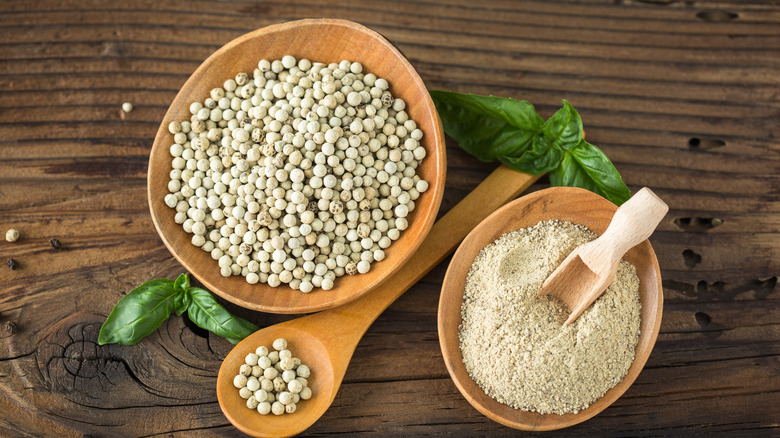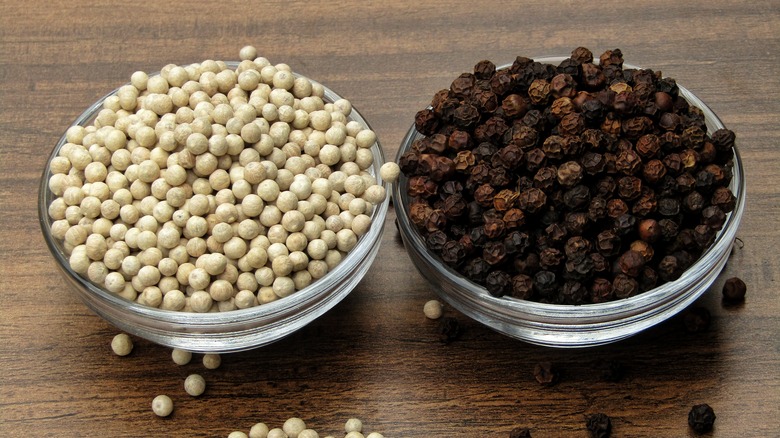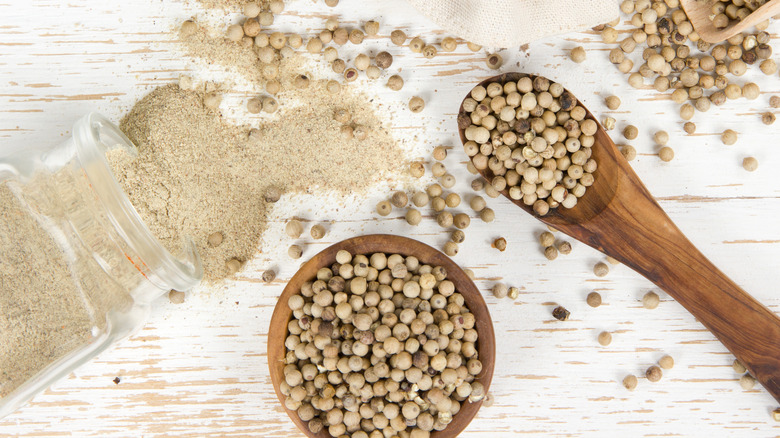The First Thing You Should Know About Cooking With White Pepper
White pepper is a floral, grassy spice that lends aromatic heat to many dishes, but it can also add an uncomfortable tickle to your sinuses. When cooking with white pepper, be careful about how you use it. It can easily become an irritant to the eyes, nose, and throat, which can be exacerbated by using finely ground white pepper.
All peppercorns — no matter the color — contain an alkaloid called piperine that gives them their spicy taste. When breathed in, it aggravates nerves in the mucous membranes of our noses, causing the body to sneeze. Luckily, the solution to this is simple. When cooking with white pepper, stand as far back as possible while adding it to a dish. Give the piperine some space to disperse, and it should leave your breathing unclogged.
To further protect your nose, purchase whole peppercorns at the store. At this point, many of us are aware that it's a mistake to pick up pre-ground black pepper, and white pepper is no different. Whole spices stay fresh and preserve their flavor better than their ground counterparts. Beyond this, you can grind the pepper to a larger size that won't be inhaled as easily.
What separates white pepper and black pepper?
While black and white pepper come from the same tropical plant, they have crucial differences. Black peppercorns are harvested unripe and then dried, which gives them their wrinkled texture. White pepper is made from the same peppercorns, but they are picked at their most ripe. They are also soaked prior to drying, which causes the outer layer to come off, and helps them retain a smooth shape.
The two spices have different flavor profiles as well. White pepper has a brighter taste reminiscent of ginger. Because white peppercorns have their outer shell removed, they contain less piperine than their black counterparts. This means that black peppercorns are spicier. Black pepper also has a woodsy, warmer flavor profile.
These two spices can be used interchangeably in small amounts, such as when adjusting seasoning after cooking a dish. White pepper is often subbed in for aesthetic purposes. Cooks may turn to white pepper in a classic homemade aioli, where black pepper spots look unappealing. The same is true for dishes like cream sauces or soups. In larger doses, however, the two spices should not be substituted. A dish like cacio e pepe — which relies on black pepper as one of its main ingredients — will taste much different if the same amount of white pepper is used.
Cook these dishes where white pepper shines
White pepper is popular throughout multiple Asian cuisines, including Chinese, Vietnamese, and Thai cooking. One of the most famous dishes built on white pepper is Chinese hot and sour soup. In this dish, dried mushrooms are simmered with tofu and sometimes pork in a rich, flavorful stock. While dried chilies can be added too, the soup's trademark heat largely comes from white pepper (the sour part of its name comes from the addition of vinegar). Add the white pepper at the end of the cooking process so that its heat and aroma aren't cooked off.
Another classic vehicle for white pepper comes from another country and continent: Swedish meatballs. The floral notes of white pepper meld with allspice and nutmeg to give the dish its characteristic tang. The meatballs are made by mixing a blend of beef and pork with eggs, bread or breadcrumbs, and spices. They are traditionally served with a creamy brown gravy, and you can double up on white pepper by using it to season the sauce. Just make sure you stand back from the pan as you add it.



